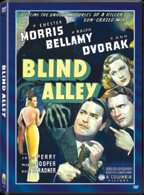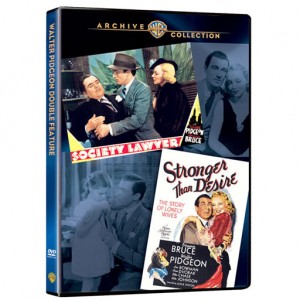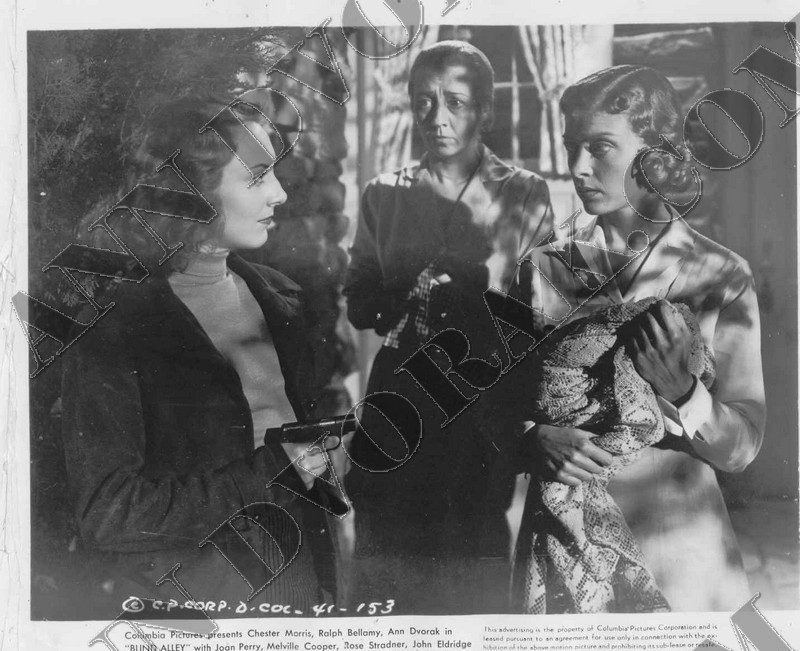Yearly Archives: 2011
Ann Dvorak DVDs from Warner Archive, a Rundown
I recently received a very nice email from a gal who commented that this site made her aware of some Ann Dvorak, Warner Archive releases she didn’t know about. Since so many of Ann’s films have been made available through the Warner Archive, though she is not always credited in the descriptions, I thought I would do a quick recap.
Before we begin, I just wanted to express how amazing the Warner Archive is. I’ve seen some snarky comments around the Web about the bare bones DVD-Rs being a rip-off at $20 a shot. All I know is that I was in the process of booking a $500 (yes, $5-0-0) screening of I Was an American Spy at the Warner Bros lot in Burbank when the Warner Archive made it one of its inaugural titles. Compared to what I was willing to pay, $20 seems like a steal and I’m sure a lot of other film fanatics have had similar experiences with hard-to-find titles. Besides, they have so many sales and promotions that I seldom have to pay the full amount.
Without further ado, here is a list of Warner Archive Divine Dvorak DVDs with descriptions that focus on Ann’s role rather than the plot of the film as a whole:
The Strange Love of Molly Louvain (1932, Warner Bros)Â – Ann’s bad taste in men leaves her with a kid out of wedlock (who has a British accent), a potential wrap sheet, and a bad blonde wig.
Stranger in Town (1932, Warner Bros) – Ann is torn between her loyalty for her grandfather (Chic Sale) and her devotion to her new squeeze (David Manners) who have competing markets in the same small town.
College Coach (1933, Warner Bros) – Neglected by her college football coach husband (Pat O’Brien), Ann casts a wandering eye on one of the team’s players (Lyle Talbot).
Heat Lightning (1934, Warner Bros) – When Ann is stifled by her desert surroundings and overprotective older sister (the always awesome Aline MacMahon), she makes some poor decisions that leave her unlucky in love.
Midnight Alibi (1934, Warner Bros) – Gangster Richard Barthelmess gets on a rival’s super bad side by falling for his kid sister (Ann-D). Can love really conquer all?
Side Streets (1934 Warner Bros) – Ann finds herself with a child out of wedlock from a scoundrel (Paul Kelly) who is already married to (the always fabulous) Aline MacMahon.
Stronger Than Desire (1939, M-G-M) – Directed by then husband Leslie Fenton, Ann looks stunning as she is accused of a murder she may or may not have committed. Highlights are an under-oath break-down, and courtroom fake faint as commanded by attorney Walter Pidgeon.
I Was an American Spy (1951, Allied Artists) – See Ann thwart the Axis powers in the Philippines, kind of do a fan dance, and sing “Because of You” before being captured and tortured by Japanese forces in this film based on the true story of Claire Phillips.
For those of you who are die-hard Dvorak devotes, the following releases feature Ann as a chorus girl or extra:
Hollywood Revue of 1929 (1929, M-G-M) – It’s all talking, all singing, all dancing, all Ann Dvorak! Well, not really, but she is in this one a lot as the chorus is featured in the bulk of the numbers. She also utters her first onscreen words, “pardon me,” to Jack Benny and slaps him.
It’s a Great Life (1929, M-G-M) – See Ann take front-and-center and dance her little heart out to the “Hoosier Hop,” a number she supposedly choreographed.
Chasing Rainbows (1930, M-G-M) – Ann’s very visible in an early backstage scene, but a big musical number at the end is missing and supplemented with scene stills.
So This is College (1929, M-G-M) – Ann is young (seventeen), sans make-up, and her eyebrows have never seen tweezers in this early talkie. She is quite visible in a couple of scenes.
Lord Byron of Broadway (1930, M-G-M) – Ann pops up in the “Old Woman in a Shoe” number.
Politics (1931, M-G-M) – Ann can be seen in the crowd at a political rally in this early pro-feminist comedy starring Marie Dressler and Polly Moran.
This Modern Age (1931, M-G-M) – Ann dances and party crashes in this Joan Crawford drama.
Love in the Rough (1930, M-G-M) – This one is only for the Ann Dvorak completest (which may just be me), as the musical number she is in was cut out.
That’s it for now. Hopefully we’ll be seeing The Crowd Roars, Housewife, and Massacre from the Warner Archive in the near future.
“Blind Alley” on DVD
Ann Dvorak made three films with Columbia in the late 1930s, none of which were ever released on VHS. Now through the Columbia Screen Classics by Request program (similar to the Warner Archive), Blind Alley is available for purchase.
I spoke about Blind Alley on a recent post when it played at the annual San Francisco Noir Festival last month, so I won’t rehash my take on it now, only to say that it’s worth a watch.
What I will talk about briefly is the box art, which uses the one-sheet for the film. Please note Ann Dvorak’s top billing on the poster and yet she is no where to be found. When I first saw this, I figured Joan Perry was the dame depicted on the poster, and did not feel so bad because she became Mrs. Harry Cohn a couple of years later. However, I later realized that it’s Rose Stradner looking so forlorn next to Ralph Bellamy and Chester Morris, and that just makes me mad. It’s one thing if the studio’s main squeeze makes it onto the advertising, but Ann getting bumped for someone so low in billing just seems wrong. I have nothing against Miz Stradner personally, I’m sure she was lovely, and I merely bear the mark of frustration after being a disgruntled Ann Dvorak fan for so many years.
Aside from my anger over advertising decisions made more than seventy years ago, I am pleased Blind Alley is being made readily available and look forward to Ann’s other two Columbia films, Cafe Hostess and Girls of the Road being released through Screen Classics by Request.
“Scarface” on TCM
Scarface is going to air on Turner Classic Movies on Friday, January 21st at 6:30pm PST.
Ann Dvorak appeared in 53 feature films (not counting her appearances as a child-actor and chorus girl). Some are lousy, others merely watchable, and a few are damn good. In my humble opinion, the one that stands above all the others and is a truly great film is 1932’s Scarface.
Directed by Howard Hawks, produced by Howard Hughes, and starring Paul Muni, Scarface is legendary for the censorship battles it sparked between Hughes and the Production Code Administration, as much as it is for being one of the quintessential gangster flicks of the early 1930s. Also, this was the film that spawned the 1983 Brian DePalma movie of the same name, starring Al Pacino. Scarface is also the first film Ann Dvorak was cast in as an actress as opposed to an extra or member of the chorus.
When watching the film, it’s hard to believe this is the first time Ann really acted on screen, and that she was barely twenty years of age. She more than holds her own with Muni, who was already an accomplished stage actor, and her scenes with an equally effective George Raft are electrifying. Her death scene could have been melodramatically comedic, but instead is quite convincing. With her heavily char-coaled eyes and teased up hair, she is never quite this striking looking in any other film.
The censorship issues with Scarface delayed the film’s release for a number of months and unfortunately, the first movie bearing the name “Ann Dvorak” was not this one, but Sky Devils, a not so funny comedy starring Spencer Tracy and featuring rehashed flying footage from Hughes’ Hell’s Angels.
Scarface is definitely “Ann Dvorak 101,” so if you haven’t seen this one before, set your dial to TCM and enjoy the debauched ride.
“Stronger Than Desire†on DVD
The Warner Archive delivers again, and this time in a most unexpected way. The past few months, they have been releasing a steady stream of Ann Dvorak’s Warner Bros flicks from the 1930s. Today, they are offering a Walter Pidgeon/Virginia Bruce two-pack including the 1939 drama Stronger Than Desire, featuring our beloved Miss D.
This M-G-M film about an attorney who defends a woman accused of a murder that may have in fact been committed by his own wife (you got that?), was directed by Leslie Fenton, Ann’s first husband. Fenton had turned in his acting cap the year before, and this was one of his first turns as a feature director. The film is enjoyable enough, and Fenton had the opportunity to direct his wife through a heart-wrenching courtroom breakdown.
I particularly like this film for two reasons. First is the scene where Walter Pidgeon has Ann fake-faint in court. He cues her and she just melts out of the chair and onto the floor. I know it’s supposed to be dramatic, but it’s pretty ridiculous and worthy of a rewind and rewatch. The other reason I find this film memorable (as far as Ann Dvorak movies go) is because she has never looked more beautiful. No studio did Hollywood glamor quite like M-G-M, and it shows. Ann is absolutely luminous, even when she is fake-fainting.
Hats off once again to the Warner Archive for fulfilling the needs of every Ann Dvorak fan, even though they’re probably not doing it consciously.
“Blind Alley” to be Screened at SF Noir Festival
It’s that time of the year when my husband and I talk about driving up to San Francisco for the annual Noir City film festival and don’t actually go. This year will be no exception, because while my 7-month-old daughter is brilliant, theater-going is not yet on her list of accomplishments.
This year’s line-up is especially of interest because they will be screening the 1939 Columbia flick Blind Alley, directed by Charles Vidor, starring Chester Morris, Ralph Bellamy, and of course Ann Dvorak.
As I have previously discussed when it has aired on television, Blind Alley is one of my favorite Dvorak films. This tale of an escaped convict who with his gang, holds a dinner party hostage at a lakeside home while waiting for an escape boat is a bit campy but mostly compelling. How can one not be engrossed watching Ralph Bellamy use his super-psychiatric powers to drive Chester Morris completely insane? Ann plays the ever-devoted girlfriend, a role that was all too familiar in her Warner Bros days. At least this time her true love is a psychotic, murdering thug, and she is a gun-toting hard-ass who looks stunning while ordering the hired help to lock themselves in the basement.
Blind Alley will be screened at the Castro Theatre on Saturday, January 29th at 1:00pm and 4:30pm. It’s part of a double feature with Fritz Lang’s Secret Behind the Door, which as my husband commented, “sounds rad.”
The Noir City festival runs from January 21-30. The full program list can be found on their website.


/Scarface6.jpg)
/ScarfaceG.jpg)

/Desire3.jpg)

